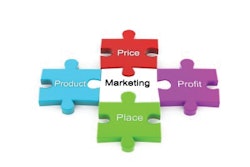
Part I of this article introduced the four key performance indicators (KPI's) of marketing and why they are important: allowable cost per lead (CPL), number of leads generated, marketing percentage and average dollars per lead (ADL). Part II focused on using these four KPI's to build a marketing plan. In Part III of this article, we will look at the power of tracking your marketing KPI's down to each individual marketing source you have.
Knowing the performance of each marketing source (the places you invest money to advertise your business - radio ads, television, print ads, Internet, yellow pages, etc.) can have a tremendous impact on your bottom line.
I will also share my top tips for lowering your marketing cost per lead.
So let's get right to it!
The Bucket Approach to Marketing
If you're like most companies, you're reporting tends to use what I call the "bucket" approach. Here's what I mean: Your reports show that you spent X dollars in marketing, you brought in X dollars in revenue and you have an ROI, for example, 10:1 on your marketing budget.
That's the bucket theory. Everything gets thrown together into one "bucket" of reports, instead of being broken down.
To help illustrate the concepts in this article I've created charts with example information. Example #1 shows a company (Company A) that spends its marketing budget evenly across five different marketing sources. Since the company uses the "bucket" approach to marketing, it knows it's spent $100,000 in marketing. Company A knows its overall CPL and ADL numbers. However, it does not know these crucial factors for each of its marketing sources.
Because of this, Company A has no way of knowing what to expect from the next $100,000 it invests into its marketing machine. Many times, this can be the reason for the "peaks and valleys" in lead flow that a company experiences.
The Details Will Set You Free
Now, let's look at how the details can tell you so much more about your marketing machine. In Example #2 you can now see the details of each marketing source for Company A. You can see the CPL and ADL for each of these sources as well as the overall "bucket" numbers that we saw in Example #1.
As you can see in this example, television ads are three times more expensive to buy than the average, while trade show leads are half the average cost. Likewise, you can see the variances in the ADL of each lead source.
This is important to remember. The "bucket" approach tells us the average overall. Like any average, some numbers will be higher and some will be lower.
So, big deal right? As long as the overall numbers are good who really cares?
You should. Let me show you why.
Amazing Differences
Example #3 shows a comparison between the marketing results between two companies with the same marketing budget.
For this example, let's suppose Company A works the old fashioned way. It "diversifies" its marketing budget, doesn't put all of its eggs in one basket and spends the marketing budget evenly among the five marketing sources.
Company A doesn't worry with the details because the overall "bucket" numbers are good.
Now, let's look at Company B. Company B not only tracks the overall "bucket" KPI numbers, but also tracks them down to each marketing source it invests money with.
Company B knows that some marketing sources perform better than others. It also knows it can reallocate its budget to those sources that perform better.
So, Company B makes a few small changes in the way it spends its marketing budget. It takes money from television advertising (because of the high CPL and low ADL) and redistributes those funds to better sources (trade shows and Internet, for this example).
With a few small changes in the way the money is spent, Company B has made major improvements on the results from its marketing machine.
Keep in mind, Company B didn't spend a dime more than Company A. However, for the same marketing budget, let's look at the differences:
- Company B generated 163 more leads (14% improvement)
- Company B lowered it's overall CPL by $14 (14% improvement)
- Company B increased it's overall ADL by $74 (6% increase)
- Company B Generated $278,039 more revenue (20% increase)
WOW! A 20 percent growth in revenue - without spending another dime.
That's the power of tracking your KPI's. Not only with the overall "bucket" approach but down to the individual marketing source.
So, why stop there? What if we could buy our leads a little bit cheaper? Would it be unrealistic to think we could cut $10 off of the average CPL for our Company B example?
4 Insider Tips To Lower Your Cost Per Lead
These tips come right out of my playbook. Let's dig in!
- Work On Headlines In Your Print Ads - The headline is what captures the reader's initial attention. With so many advertisements being thrown at your customers every day, you really need to work on your headlines. If it's not your cup of tea, find someone who can help you.
- Focus For "Push" Style Marketing - Anytime you are pushing a message onto a prospect who is not intentionally seeking to find your company (radio, television, direct mail, etc.) you need to have a different approach. The person who is actively seeking out your services is in a different "mode" of receiving information that the person who is not. Focus your efforts on increased quantity of exposures, building trust in your company name and building your authority status in your industry. Focusing on lead generation alone will likely give you poor results.
- Focus For "Pull" Style Marketing - When a prospect is actively searching for your service, focus your advertisements on the prospect's needs/wants/pains/pleasures. Avoid all of the "what we do" and "who we are" junk. They don't care.
- Remnants - Contact offline advertisers and offer to buy up their unsold "remnant" ad space. Offer to do it on a pay-per-lead basis. The key here is to contact them again shortly before their advertisements "drop". The leftover ad space won't bring them any money, so you have a good bit of leverage to work with.
In case you're wondering… is it worth the effort? Take a look at Example #4. This chart shows a comparison in marketing results by a slight improvement in the companies' CPL rate.
If Company B could lower its overall CPL by $10 it could again grow its revenue by over $220,000. Again, without spending another dime in marketing.
Wrapping Up
This three-part article has covered a lot of ground. I hope you'll consider implementing these approaches into your own marketing machine.
Feel free to send me an email if you have any questions about these topics. I'm always excited to talk to others about their marketing goals!
Till next time!
Damion Rutherford is an 11 year vet in the construction marketing industry. He's personally generated over 150,000 leads and millions in revenue for home improvement contractors across the country. Learn his insider secrets to construction marketing at www.Contractor-Marketing-Tips.com.



















